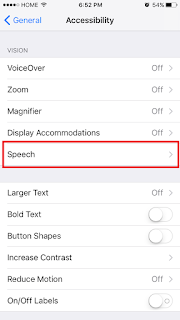In this post, I will mention one of the greatest but less used feature of iPhone...
1- Tap on "Settings" app.
2- Tap on "General"
3- Tap on "Accessibility"
4- Tap on "Speech"
5- Activate "Speak Selection" switch.
========================================================================
If you select any text before activating Speak Selection Switch, you will see following available options: Copy, Look Up, Spell, Share... except Speak
Do you know that your phone is able to speak? I think most of you know that it is so.
But I am not talking about Siri...
What I am talking about is "Speech" feature of iPhone.
By activating this feature, you would be able to make your phone read articles and books aloud to you while driving to home/work/school or while cooking etc. In this way, you will no more need to buy Audio books if you have any non-Audio one. You can transforms your e-books or e-sources into Audio books or Audio sources. Or instead of listening radio while driving, you can listen some articles that you bookmarked or added to reading list but do not have chance to read it.
This feature is OFF by default in iOS. You should activate it before using.
Here is how you can activate and use this feature...
1- Tap on "Settings" app.
2- Tap on "General"
3- Tap on "Accessibility"
4- Tap on "Speech"
5- Activate "Speak Selection" switch.
========================================================================
If you select any text before activating Speak Selection Switch, you will see following available options: Copy, Look Up, Spell, Share... except Speak
After activating Speak Selection Switch, you will see the option "Speak". Tap on "Speak" option and let your phone read a book or article for you.
One More Great Feature: Speak Screen
If you activate this switch, you can hear the content of the screen by just swiping down your two fingers from the top of the screen.
After you swipe down your two fingers on the screen, a speak screen appears and content of the page is read aloud by your phone. Unless you stop the speech, whole book can be read aloud to you. You can use buttons on Speak Screen to control speech speed (turtle and rabbit buttons) or Pause/Play.
Note: This feature is tested on iOS 10.3.1










Comments
Post a Comment